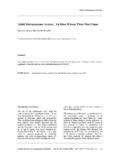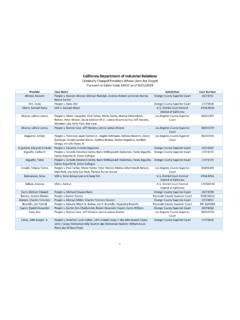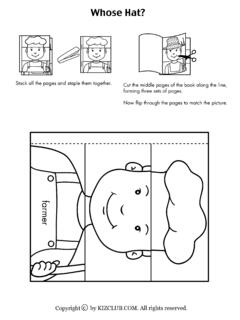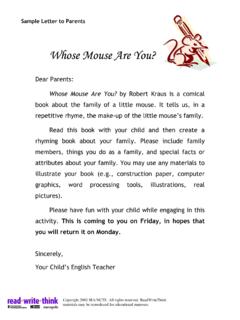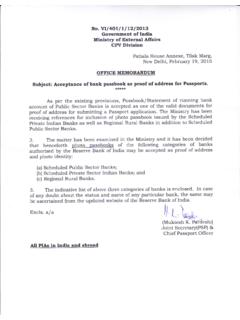Transcription of “The true meaning of life is to plant trees, under …
1 The Carpenter Foundation The true meaning of life is to plant trees, under whose shade you do not expect to sit. Nelson Henderson50 YEARS OF GROWING COMMUNITYAmy Cuddy, writer and editor | Michael Lee, Design The purpose of the Carpenter Foundation is to add opportunity, choice, inclusiveness, enrichment and a climate for change for those living in the Rogue Valley. The Foundation works in partnership with other agencies, organizations and public entities. Sisters Karen Carpenter Allan and Emily Carpenter Mostue serve as Vice-President/Secretary and President, respectively, of the Carpenter CelebrationAll organizations evolve over their life span, just like people, and that is certainly true of the Carpenter Foundation. Over 50 years, the Foundation, which began as a vehicle for personal giving by Helen and Alfred Carpenter, has developed into a stand-alone entity with established grant-making guidelines. As the third genera-tion of the Carpenter family moves into the leadership role, non-family-member trustees take on greater re-sponsibilities.
2 Ours is an organization that has gone from its infancy in 1958 to mature adulthood in 2008. This is thanks to all those who contributed their efforts with thoughtfulness and generosity along the and Helen Carpenter gave the funds and set up the foundation in 1958. Their goal was to give back and support and shape the community and causes they loved. Jane and Dunbar Carpenter picked up the mantle and spent countless hours nurturing nonprofit organ-izations with knowledge and compassion, managing financial resources, and developing a foundation that was open and accessible. Many public trustees have contributed their time and wisdom and have given the Foundation a far broader Carpenter Foundation does not work alone. We are in partnership with the myriad of nonprofit organizations in this two-county region that devote their efforts, finan-cial and personal resources, and blood, sweat, and tears to serving and enriching our communities.
3 We are in awe of the dedicated and committed individuals who believe strongly that it is their job to make our community we celebrate our 50th anniversary, honoring those who have gone before and anticipating the Carpenter MostuePresidentCarpenter Foundation Responsibility does not only lie with the leaders of our countries or with those who have been appointed or elected to do a particular job. It lies with each of us individually. Dalai Lama Alfred St. Vrain CarpenterHelen Bundy Carpenter2 The Founders: Alfred and Helen CarpenterAmerican statesman Daniel Webster observed that, When tillage begins, other arts will follow. The farmers, therefore, are the founders of civilization. So it was with the Carpenters and the Rogue Valley: they came to farm and cultivated both the land and the from Colorado to Medford by family friend Reginald Parsons of Hillcrest Orchard, brothers Leonard and Alfred Carpenter planted a pear orchard in 1909, using a draft horse team.
4 The Harvard-educated brothers knew little about agriculture. After college Leonard had been an electrical engineer, and Alfred had worked in the real estate and bank-ing businesses. What they lacked in experience, however, they more than made up for with a strong work ethic, a vision of abundance, and a willing-ness to immerse themselves in study and learning. As a friend and reporter for the local paper noted, Alfred and Leonard were charming, gracious men, unaffected and unassuming, and each possessed a subtle, sometimes off-beat but never mean, sense of humor. Their older brother, Dunbar F. Carpenter, followed Leonard and Alfred to Medford. Concerned about supporting his young family, Dunbar practiced law rather than joining his brothers in their orchard. After a few years, in 1917, Dunbar packed up his family, moving first to Berkeley, California, and then back to Boston to be closer to his wife s family, leaving the pears and the Rogue Valley to his brothers.
5 By this time Alfred and Leonard were taking turns tending to their orchard. In 1920, Alfred set out to travel around the world, while Leonard and Winifred, his wife of three years, stayed behind to look after things. On his trip Alfred met and fell in love with the bright and gracious Helen Bundy, and they were married in Cairo in 1922. After living in Pasadena, Brothers Alfred and Leonard Carpenter working their farm in 1910 Almost every good thing you can think of in this valley, they (Alfred and Helen) had touched it. Shirley Patton, community leaderThe Carpenter brothers home, including a water tower, on the hilltop overlooking their orchard at Hillcrest and Foothill Roads3 California, for a few years, they returned to the Med-ford area in 1926. They bought land on Old Stage Road near Jacksonville, planted a small orchard, and built a large and inviting home they called Topsides. Topsides became the site of numerous social events, often for the benefit of local organizations.
6 Helen, an avid and talented gardener, created the lovely grounds around the and Leonard and their wives were very commu-nity-minded. Leonard helped organize Southern Oregon Sales, a fruit-growers cooperative, and the Medford Irrigation District, both of which made the difference between success and failure for local orchardists. In ad-dition, Leonard and Winifred s love of the arts prompted them to become patrons of many local cultural , in 1942, Alfred and Helen Carpenter formed the Jackson County Recreation Committee to provide activities and entertainment for military personnel. They did this not only to help with the war effort but also to support their fellow citizens. With 40,000 servicemen stationed only a few miles away at Camp Alfred and Helen Carpenter at Topsides with their children, Julie and HarlowAlfred and Helen Carpenter at the 1958 groundbreaking for the Rogue Valley Medical Center on Barnett Road4 White, many of Medford s 10,000 residents worked hard to keep the soldiers happy and engaged in positive pur-suits.
7 The Jackson County Recreation Committee acquired what is now the University Club, originally built and used by the Pacific Telephone Company, to provide a venue for for the Recre-ation Committee came primarily from Helen. Her father, Harlow Bundy, and his brother had founded the Bundy Time Machine Company in Binghamton, New York, in 1889. This fledgling company grew and merged with several oth-ers to become IBM in 1924, making Helen and her two siblings the owners of some very valuable World War II ended, so too did the need to entertain the Camp White servicemen. Alfred and Helen s charitable activities, however, contin-ued unabated. They helped friends and contemporaries in need. They paid for worthy students to attend college. They were the major donors to the Community Hospital (later the Rogue Valley Memorial Hospital and now Rogue Valley Medical Center), the Red Cross chapter house in Medford, and the Carpenter Center for the Visual Arts at Harvard University.
8 Many of their contributions were anonymous, and all were 1958 the Jackson County Recreation Committee was reorganized as the Carpenter Foundation, evolving from a personal vehicle for charitable giving to a general purpose family foundation, with a board of five trustees. The Foundation s first grant recipients included the hospital and the Oregon Shakespeare what was to become a hallmark of the Carpenter Foundation, Alfred and Helen cared deeply about the organizations that the Foundation supported and contrib-uted considerable time, as well as money, to strengthen them. Alfred brought his farmer s work ethic to the Rogue Valley Medical Center board, on which he served for nearly 40 years, including 11 years as president. He envisioned and oversaw numerous expansions and construction projects, including a cancer treatment center and a coronary care unit, and he also developed a fund for newborn indigent care. Helen Carpenter, here with daughter Julie, loved children.
9 5 Alfred took a personal inter-est in the hospital and its employees. Over many years he seldom missed his weekly visits, during which he toured the hospital, talking with employees and physicians. According to a 1975 hospital newsletter, Mr. Carpenter was a man who never ran out of ideas about what the hospital should be doing, and he joined with others to ensure that it was done. Helen contributed, too. When the hospital moved from downtown to its current loca-tion on Barnett Road, Helen stepped forward to help with the interior design. She was mindful of the needs of community members and insisted on a high-quality facility to serve them. While Alfred always seemed to have a twinkle in his eye, Helen was a bit more formal. Digni-fied yet caring, Helen s love of children and genuine interest in them was extraordinary. The third floor of Topsides was turned into a theatre in which her two children, Julie and Harlow, and their friends performed to Helen s delight.
10 Each summer Helen and Alfred would host a picnic for the Oregon Shakespeare Festival company, many of whom were college students. The young people were treated like honored guests and looked forward with great anticipation to the beautiful gardens, delicious food, and Alfred and Helen s Helen learned that the Festival s outdoor theatre had been condemned, in part because water was draining into the area where the electricians worked, she decided to help keep these kids safe. Alfred and Helen made a substantial grant to the Festival to rebuild the theatre, but they didn t stop there. They insisted that the Festival challenge the citizens of Ashland to match the grant, encouraging the entire community to get involved. Graciously yet firmly they (Alfred and Helen) have strengthened the fabric of this their chosen community, with threads of purpose, brightened it with the color of compassion. The Red Cross chapter house dedication booklet, 1957 Dunbar Carpenter checks Dunbar Orchards and Jane Carpenter Like Alfred and Helen before them, Dunbar and Jane Carpenter were good at growing things: crops, gardens, organizations, and the was born in Medford in 1915, after his father, Dunbar F.
